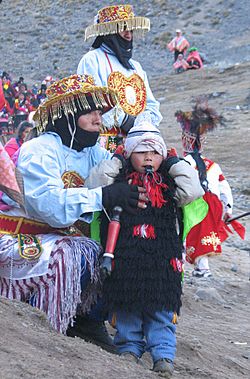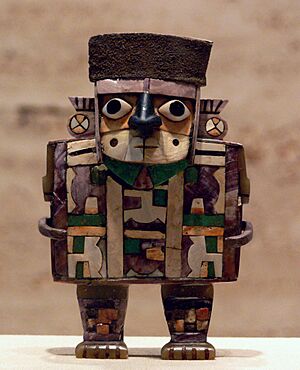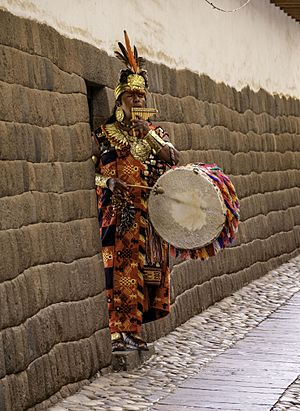Indigenous peoples in Peru facts for kids

Dancers at Quyllurit'i, an Indigenous festival in Peru
|
|
| Total population | |
|---|---|
| 5,500,000 24% of Peru's population |
|
| Regions with significant populations | |
| Mainly southern regions and Amazon basin (Apurímac, Ayacucho, Huancavelica, Cusco, Arequipa, Puno, Loreto, Junín, Pasco, Huánuco, Ucayali, and Madre de Dios). | |
| Languages | |
| Quechua, Aymara, Peruvian Spanish, and other Indigenous languages | |
| Religion | |
| Roman Catholicism, Native religions | |
| Related ethnic groups | |
| Mestizo, other Quechua, Aymara |

The Indigenous peoples of Peru are the first people who lived in the land now called Peru. They include many different ethnic groups. Their cultures grew and changed for thousands of years before the Spanish arrived in 1532.
In 2017, about 5.5 million Peruvians said they were Indigenous. This was about 24% of Peru's total population. When the Spanish came, many Indigenous groups lived in the Amazon basin. These groups were often semi-nomadic tribes. They found food by hunting, fishing, gathering, and using slash-and-burn farming.
Other Indigenous peoples lived in the Andes mountains and to the west. They were part of the powerful Inca Empire. The Inca had a complex society with many cities. They built amazing temples and monuments using advanced stone-building skills.
Many of the estimated 2,000 nations and tribes from the 1500s disappeared. This happened because of the growth of the Inca Empire. Later, even more disappeared after 1533, when the Spanish Empire took over. Today, people of mixed Indigenous and European background, called mestizos, make up the largest part of Peru's population.
When the Spanish arrived, many Native Peruvians died from new diseases. These diseases came from Europe and Asia. The local people had no natural immunity to them.
All Indigenous groups in Peru, even those living deep in the Amazon rainforest, have changed their lives. They have been influenced by European-Peruvian culture. For example, they now use firearms and other manufactured items. They also trade goods. Still, many groups work hard to keep their traditional cultures and identities alive.
Contents
The First People of Peru

Scientists study human history and genetics to understand where people came from. Evidence shows that most of the first people in the Americas came from North Asia (Siberia). They crossed the Bering Strait into North America in at least three different groups.
DNA studies suggest that most people living in Peru in 1500 came from the first group of Asian travelers. These travelers likely crossed a land bridge called Beringia. This happened at the end of the last ice age, around 24,000 BCE. It is thought that these first travelers reached Peru by 10,000 BCE. They probably entered the Amazon basin from the northwest.
The Norte Chico civilization in Peru is the oldest known civilization in the Americas. It is one of six places in the ancient world where civilization began. This includes farming and organized government. These ancient sites are about 100 miles north of Lima. People there traded between coastal fishermen and cotton growers. They built huge pyramids around 3000 BCE.
Before the Spanish arrived, many different languages were spoken in Peru. These included Quechua, Aymara, and Jivaroan. The people had different ways of organizing their societies. They also had unique languages and cultures.
Where Indigenous People Live in Peru
The National Institute of Statistics and Informatics says that Indigenous people make up about 25.7% of Peru's population. Most of them (95.8%) live in the Andes mountains. About 3.3% live in the Amazon region. Other sources say the number is closer to 31% of the total population.
In the Amazon region, there are more than 65 different ethnic groups. They speak languages from 16 different language families. Peru is thought to have the most uncontacted tribes in the world. These are groups who live without contact with the outside world.
Life After the Spanish Conquest
After Spanish soldiers arrived in Peru, many local people started to die. They caught diseases from Europe and Asia. These diseases were common among the foreigners. But Indigenous people had no natural immunity to them. The diseases spread quickly along trade routes, often before the Spanish even reached certain areas. This caused many deaths.
Marriage and Family Life
In traditional Indigenous cultures, women often married around 16 years old. Men usually married when they were about 20. Before the Spanish arrived, the Inca people sometimes had "trial marriages." These marriages lasted a few years. At the end, both the man and woman could decide if they wanted to stay together or go back home.
In Andean cultures, people understood that men's and women's work was equally important. They depended on each other for the community to survive. Once married, women often stayed home. They cared for children and animals, collected food, cooked, and wove cloth. Men often took on more physically demanding jobs.
Mixed Marriages in Peru
From the very beginning, Spanish soldiers and settlers married Indigenous women. Important Spanish leaders married into the Inca royal families. Other marriages happened among different social classes. Today, a large part of Peru's population is mestizo. These are people with both Indigenous and European ancestors. They usually speak Spanish and are Roman Catholic. They are part of the main culture in Peru.
In the late 1800s, many Chinese men came to Peru as laborers. They worked on farms, especially in the north. Because there were not many Chinese women, these men often married non-Chinese women. Many of these women were Indigenous Peruvians. In recent times, scholars have studied these marriages and the mixed cultures that grew from them.
Chinese men also formed relationships with Peruvian women in cities. These women often came from Andean and coastal areas to work. Chinese men often preferred to marry Indigenous Peruvian women over African Peruvian women. Sometimes, matchmakers would arrange large group marriages. They would bring together young Peruvian women and new groups of Chinese laborers.
In 1873, The New York Times wrote about Chinese laborers in Peru. It said their work was like slavery. But it also reported that Peruvian women wanted to marry Chinese men. They saw them as good husbands: "hard-working, affectionate, faithful and obedient."
Some Peruvians did not like these mixed marriages. They had concerns about different races marrying. When Indigenous Peruvian women and Chinese men had children, these children were called injerto. As adults, injerto women were often preferred as wives by Chinese men, as they shared a mixed background.
Understanding Gender Roles
In ancient Inca culture, gender was understood differently at different ages. For example, children under 3 were called "Wawa." From 3 to 7, they were "Warma." As they grew older, different terms were used for males and females. For example, from 7 to 14, girls were "Thaski" and boys were "Maqt’a."
Before the Spanish arrived, the Inca also recognized a third gender called "Qariwarmi." This showed that their understanding of gender was broader than just male and female.
Spanish colonization changed how gender was seen in the Inca Empire. In the 1570s, Francisco de Toledo, a Spanish leader, made rules. He said Inca men could not wear their hair as long as women. Men could not dress like women, and women could not dress like men. People who broke these rules faced punishments.
Learning and Languages
There are big differences in test scores between Indigenous students and non-Indigenous students in Peru. Peru also has over 60 different Amerindian language groups. Many of these are not officially recognized. These language differences are a bigger problem in the Andes mountains and the Amazon jungle. They are less of a problem in the cities along the coast.
Since the mid-1900s, Peru has tried to improve education for Indigenous communities. They started bilingual education. This means teaching in both Spanish and Quechua or other Indigenous languages. Quechua became an official language of Peru in 1975. While its use is now limited to certain regions, it is still seen as equal to Spanish in some areas.
People who support bilingual education believe it creates a more "fair, diverse, and respectful society." They think it helps Indigenous groups gain social, economic, and political rights. It also encourages "Indigenous independence and cultural pride." However, some Quechua speakers in the highlands have criticized bilingual education. They feel it might stop them from getting ahead in society. Historically, learning Spanish was seen as the only way to succeed.
Even though Peru has good laws for Indigenous education, putting them into practice has been hard. Teachers often agree with the idea but find it difficult to teach in two languages. They also often have very few resources. But studies have shown that using a child's native language in school helps them participate much more in learning.
Because there hasn't been a strong national plan for bilingual education, many smaller efforts have started. The National Division of Intercultural Bilingual Education (DINEBI) was created. Another program, FORMABIAP, trains Native Bilingual Teachers. This program focuses on the Amazon regions of Peru.
Indigenous Lands
Indigenous people own large parts of Peru. These lands are mostly called communal reserves (Spanish: reservas comunales). The largest Indigenous communal reserve in Peru belongs to the Matsés people. It is located on the border with Brazil, along the Javary River.
Laws and Rights
In 1994, Peru signed an international law about Indigenous people. It is called the Indigenous and Tribal Peoples Convention, 1989. This law says that governments must make sure Indigenous peoples have equal rights. They must also protect their cultures and help close the gaps in wealth and opportunity.
To do this, governments should talk to Indigenous communities about any laws that affect them. They should also let Indigenous people help make decisions. Governments should also give support and resources to these communities. This helps them develop their own ways of life. How well Peru follows this law is still debated. This is especially true when it comes to using Indigenous lands for money-making projects. Indigenous peoples only gained the legal right to be consulted in 2011.
Indigenous Organizations
One important traditional organization in Indigenous communities is the Rondas Campesinas. These are local groups that act as civil defense patrols. They started to protect land from invasions. Later, they became important in fighting against the Shining Path guerrilla movement. Rondas Campesinas still work in northern Peru, but their role is not as big as it used to be.
Recently, there has been a push for Indigenous communities to have their own regional governments. The Wampis Nation in the Peruvian Amazon was the first to set up its own government in 2015. Other groups like the Kandozi, Shawi, and Shapra peoples have followed. These governments aim to protect their lands from outsiders who want to take resources. They also help Indigenous communities talk better with the Peruvian government. The Wampis government has even started its own radio station. It is also working to stop illegal mining in its area.
Other groups work to represent Indigenous interests in Peruvian politics. AIDESEP (Interethnic Association for the Development of the Peruvian Jungle) defends the rights of 64 Indigenous groups in the Peruvian Amazon. Another group, MATSES, is run by members of the Matsés community. Its goal is to protect Matsés culture and lands without outside influence.
Indigenous Ethnic Groups
- Achuar, Amazon
- Aguano, Amazon
- Aguaruna, Amazon, northern Peru
- Amahuaca, Amazon, eastern Peru
- Asháninka, Amazon: Junín, Pasco, Huánuco, and Ucayali Region
- Aymara, who live primarily in the south.
- Bora, Amazon, north and eastern Peru
- Candoshi, Amazon: Loreto Region
- Cashibo, Amazon
- Chanka, whose direct descendants live primarily in Apurímac, Ayacucho and Lamas.
- Chincha, formerly the Pacific Coast
- Cholones, Amazon
- Cocama
- Cocamilla
- Ese Ejja, Amazon: Madre de Dios Region
- Harakmbut, Amazon: Madre de Dios Region
- Huambisa, Amazon
- Jibito, Amazon
- Jivaro, Amazon, northern Peru
-
- Shuar, Amazon
- Kaxinawá, Amazon
- Kulina, Amazon
- Korubo
- Machiguenga, Amazon, southeastern Peru
- Machinere, Amazon
- Maina, Amazon
- Mashco-Piro, Amazon: Madre de Dios Region
- Matsés (Mayoruna), Amazon
- Muinane
- Norte Chico civilization (9210–1800 BCE), Pacific coast
- Pocra culture (500–1000 CE), Pacific coast
- Ocaína
- Q'ero, Andes: Cusco Region
- Quechua, direct descendants of the common people from the Inca Empire, who are the majority in the coastal and Andean regions.
-
- Quijos-Quichua, lowland Quechua of the Napo river. Amazon: Loreto Region
- Canelos-Quichua, lowland Quechua of the Tigre and Corrientes rivers. Amazon: Loreto Region
- Southern Pastaza Quechua, lowland Quechua primarily living south of Andoas in the Pastaza River basin. Amazon: Loreto Region
- Lamas Quechua, lowland Quechua living along the Huallaga and Mayo rivers. Amazon: San Martín Region
- Secoya, Amazon, northern Peru
- Shapra, Amazon: Loreto Region
- Shipibo-Conibo, Amazon: eastern Peru
- Ticuna, Amazon
- Tukano
- Urarina, Amazon: Loreto Region
- Uru, Andes: Lake Titicaca
- Huanca, Andes: Junín Region
- Witoto (Huitoto), Amazon, northern Peru
- Yagua, Amazon: northeastern Peru
- Yaminawá, Amazon: Madre de Dios Region
- Yanesha', Amazon: Huánuco, Junín, and Pasco Region
- Yine, Amazon: Cusco, Loreto, and Ucayali Region
- Yukunas
- Zaparo, Amazon, northern Peru
See also
 In Spanish: Anexo:Pueblos originarios del Perú para niños
In Spanish: Anexo:Pueblos originarios del Perú para niños
- Cerro de la Sal (Salt Mountain)
- Interethnic Association for the Development of the Peruvian Rainforest
- Indigenous peoples in South America
- Pre-Columbian goldworking of the Chibchan area


